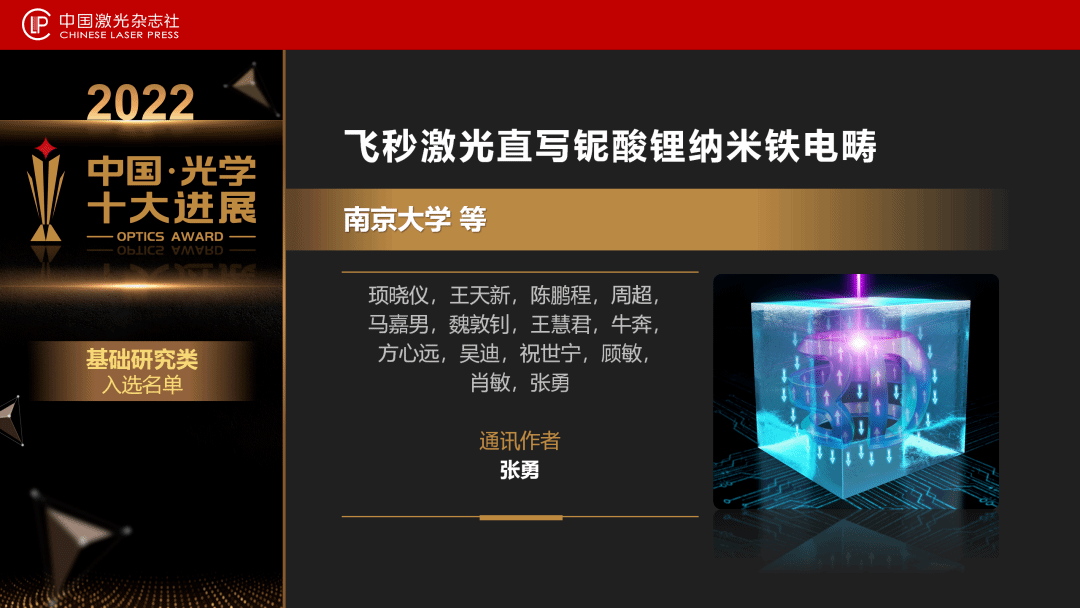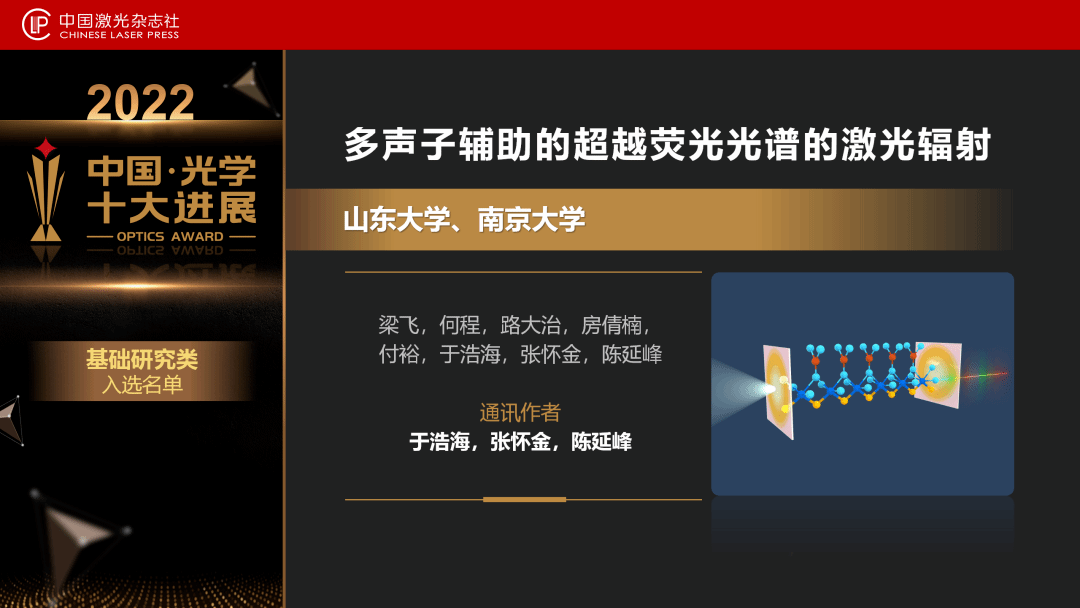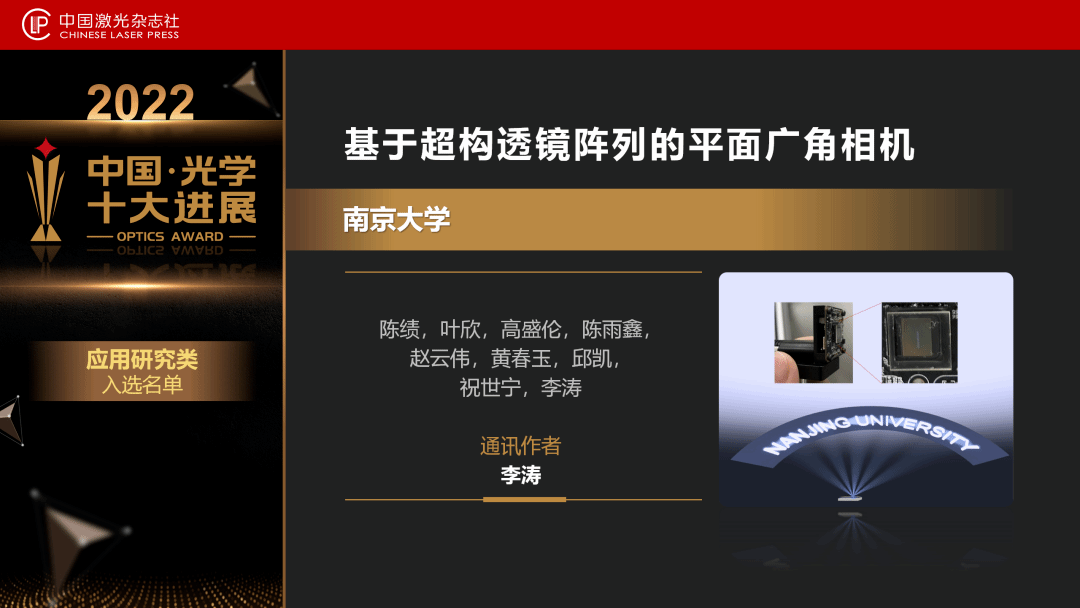The achievements of two basic research projects and one applied research project conducted by NJU teams are listed in the recently-released “2022 China Optics Award Top 10”. They are, in the basic research category, “Femtosecond laser writing of lithium niobate ferroelectric nanodomains” by Professor Zhang Yong and team, “Multiphonon-assisted lasing beyond the fluorescence spectrum” by Professor Chen Yanfeng and team, and, in the applied research category “Planar wide-angle-imaging camera enabled by metalens array” by Professor Li Tao and team.

Femtosecond laser writing of lithium niobate ferroelectric nanodomains

Lithium niobate (LiNbO3) is viewed as a promising material for optical communications and quantum photonic chips. Recent breakthroughs in LiNbO3 nanophotonics have considerably boosted the development of high-speed electro-optic modulators, frequency combs and broadband spectrometers. However, the traditional method of electrical poling for ferroelectric domain engineering in optic, acoustic and electronic applications is limited to two-dimensional space and micrometre-scale resolution. Professor Zhang Yong and team demonstrate a non-reciprocal near-infrared laser-writing technique for reconfigurable three-dimensional ferroelectric domain engineering in LiNbO3 with nanoscale resolution. The proposed method is based on a laser-induced electric field that can either write or erase domain structures in the crystal, depending on the laser-writing direction. This approach offers a pathway for controllable nanoscale domain engineering in LiNbO3 and other transparent ferroelectric crystals, which has potential applications in high-efficiency frequency mixing, high-frequency acoustic resonators and high-capacity non-volatile ferroelectric memory.
Multiphonon-assisted lasing beyond the fluorescence spectrum

Lasing typically starts from fluorescence, and the laser wavelength is therefore limited to the fluorescence spectrum of the gain material. Accessing wavelengths beyond this intrinsic emission spectrum requires emission assisted by multiphonon processes. However, this is much weaker than the fluorescence originating from direct transitions between electronic energy levels, which only involve a small number of phonons. Professor Chen Yanfeng and team present the realization of lasers far beyond the fluorescence spectrum in Yb-doped YCa4O(BO3)3 crystals. The team selectively amplify three- to eight-phonon processes and suppress all the fewer-phonon ones, which we attribute to constructive interactions of vibrational modes from free oxygen sites. The team obtain an overall spectral tuneability of 1,110–1,465 nm in five segments, each with its own configuration, corresponding to the three- to seven-phonon cases. The longest (eight-phonon) lasing wavelength can reach 1,518 nm, over 400 nm beyond the fluorescence spectrum. The results shed light on strengthening the original weak electron–phonon–photon interaction and give rise to a search for on-demand lasers operating outside the fluorescence spectrum.
Planar wide-angle-imaging camera enabled by metalens array

Wide-angle imaging is an important function in photography and projection, but it also places high demands on the design of the imaging components of a camera. To eliminate the coma caused by the focusing of large-angle incident light, traditional wide-angle camera lenses are composed of complex optical components. Prof. Li Tao and team propose a planar camera for wide-angle imaging with a silicon nitride metalens array mounted on a CMOS image sensor. By carefully designing proper phase profiles for metalenses with intentionally introduced shifted phase terms, the whole lens array is capable of capturing a scene with a large viewing angle and negligible distortion or aberrations. After a stitching process, we obtained a large viewing angle image with a range of >120∘ using a compact planar camera. The device demonstrates the advantages of metalenses in flexible phase design and compact integration, and the prospects for future imaging technology.
The annual "China Optics Award Top 10" was established by China Laser Magazine and has been held successfully for 17 sessions. Its primary objective is to promote the broad dissemination of China's outstanding optical research findings and contribute to the development of the country's optical industry. With rigorous and impartial evaluation procedures and high-level candidates, this award is highly regarded by the industry and enjoys considerable credibility and influence.
Translator: Chen Tingyu
Editors: Chen Xing, He Yao
